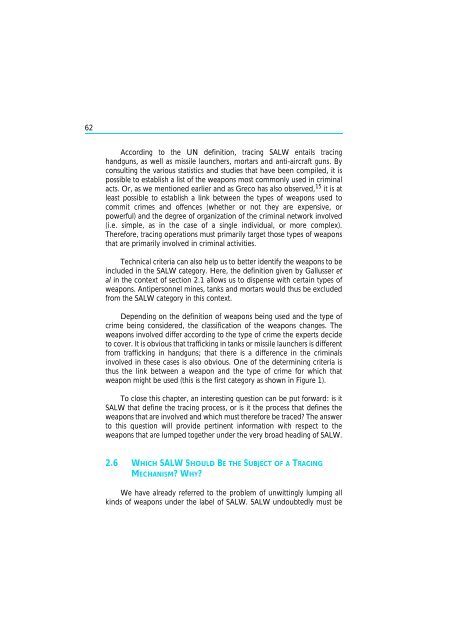The Scope and Implications of a Tracing Mechanism for Small Arms ...
The Scope and Implications of a Tracing Mechanism for Small Arms ...
The Scope and Implications of a Tracing Mechanism for Small Arms ...
You also want an ePaper? Increase the reach of your titles
YUMPU automatically turns print PDFs into web optimized ePapers that Google loves.
62<br />
According to the UN definition, tracing SALW entails tracing<br />
h<strong>and</strong>guns, as well as missile launchers, mortars <strong>and</strong> anti-aircraft guns. By<br />
consulting the various statistics <strong>and</strong> studies that have been compiled, it is<br />
possible to establish a list <strong>of</strong> the weapons most commonly used in criminal<br />
acts. Or, as we mentioned earlier <strong>and</strong> as Greco has also observed, 15 it is at<br />
least possible to establish a link between the types <strong>of</strong> weapons used to<br />
commit crimes <strong>and</strong> <strong>of</strong>fences (whether or not they are expensive, or<br />
powerful) <strong>and</strong> the degree <strong>of</strong> organization <strong>of</strong> the criminal network involved<br />
(i.e. simple, as in the case <strong>of</strong> a single individual, or more complex).<br />
<strong>The</strong>re<strong>for</strong>e, tracing operations must primarily target those types <strong>of</strong> weapons<br />
that are primarily involved in criminal activities.<br />
Technical criteria can also help us to better identify the weapons to be<br />
included in the SALW category. Here, the definition given by Gallusser et<br />
al in the context <strong>of</strong> section 2.1 allows us to dispense with certain types <strong>of</strong><br />
weapons. Antipersonnel mines, tanks <strong>and</strong> mortars would thus be excluded<br />
from the SALW category in this context.<br />
Depending on the definition <strong>of</strong> weapons being used <strong>and</strong> the type <strong>of</strong><br />
crime being considered, the classification <strong>of</strong> the weapons changes. <strong>The</strong><br />
weapons involved differ according to the type <strong>of</strong> crime the experts decide<br />
to cover. It is obvious that trafficking in tanks or missile launchers is different<br />
from trafficking in h<strong>and</strong>guns; that there is a difference in the criminals<br />
involved in these cases is also obvious. One <strong>of</strong> the determining criteria is<br />
thus the link between a weapon <strong>and</strong> the type <strong>of</strong> crime <strong>for</strong> which that<br />
weapon might be used (this is the first category as shown in Figure 1).<br />
To close this chapter, an interesting question can be put <strong>for</strong>ward: is it<br />
SALW that define the tracing process, or is it the process that defines the<br />
weapons that are involved <strong>and</strong> which must there<strong>for</strong>e be traced? <strong>The</strong> answer<br />
to this question will provide pertinent in<strong>for</strong>mation with respect to the<br />
weapons that are lumped together under the very broad heading <strong>of</strong> SALW.<br />
2.6 WHICH SALW SHOULD BE THE SUBJECT OF A TRACING<br />
MECHANISM? WHY?<br />
We have already referred to the problem <strong>of</strong> unwittingly lumping all<br />
kinds <strong>of</strong> weapons under the label <strong>of</strong> SALW. SALW undoubtedly must be
















